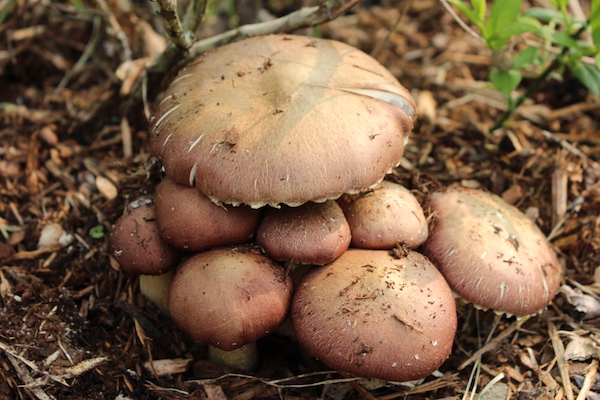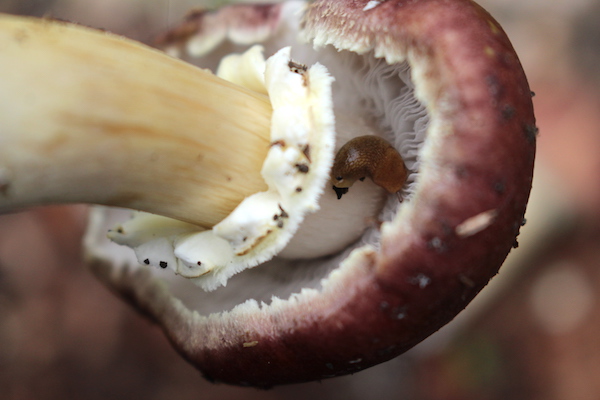Affiliate disclosure: This post may contain affiliate links. Please see our Privacy Policy.
Winecap mushrooms (Stropharia rugosa-annulata) are one of the easiest mushrooms to grow at home. They’ll grow on woody mulch or straw outdoors, and they’re commonly grown in full sun right in the garden. They’re a great way to mulch your garden beds and grow mushrooms at the same time!

When we started growing winecap mushrooms about a decade ago, our goal wasn’t to harvest edible mushrooms. We were excited about building living soil, adding nutrient-rich organic matter, and eventually turning waste wood chips into rich mushroom compost.
We’d heard that winecap mushrooms were incredibly easy to grow, and after we inoculated our first batch of woodchip mulch they’ve been carefree ever since. Occasionally I’ll take a handful of mycelium-rich chips to a new fresh pile (of straw or woodchips), but more often than not, the vigorous spores will find their way there without my help.
Just a small bag of winecap sawdust spawn is all you need to grow a lifetimes supply of winecap mushrooms for your table (or for an infinite supply of mushroom compost).

What Are Winecap Mushrooms?
Winecap mushrooms are a common, easy-to-grow edible mushroom that’s popular with permaculture gardeners. The common name “wine caps” comes from their color, since they often have deep burgundy wine-colored caps, and look brown or tan sometimes. They also go by the names King Stropharia, or their Latin name, Stropharia rugosa-annulata.
They’re known for quickly composting woody mulch, which helps nurture plants (especially perennials).
The mycelium naturally penetrates deep into the soil, far below the mulch line. This helps invigorate clay soils and create channels for nutrient flow deep into the root zone.

Winecaps also happens to be an edible mushroom, which means they’re working double duty in the garden.
While they are “edible,” most people don’t consider them to be a choice mushroom. They’re not exactly morels, but they are a nice addition to an omelet. To me, they taste an awful lot like oyster mushrooms. Vaguely woody, and well, mushroom-y.
They’re only good for about 12 to 24 hours after harvest, so you’ll never see them in the grocery store. That’s the real reason I think they’re not that popular. If you want to taste winecaps, you’ll need to grow them yourself.
Luckily, they’re incredibly prolific and we have literally harvested them by the wheelbarrow full from our small garden beds. We inoculated the straw under our everbearing strawberry plants, and they’ll flush in the spring while the strawberries are just flowering.

They’ll continue to flush all summer long, so once the strawberries take a break in the heat of the summer you’ll still have buckets of mushrooms to harvest. Just companion planting strawberries with mushrooms, we’re able to harvest more than we can possibly use.
My daughter loves to pick them, and she skipped around in her rain boots at two years old harvesting (and shredding) the caps, sprinkling them here and there like a baby mushroom fairy. That’s one reason they grow everywhere now, just a tiny piece of cap tossed on woody debris and you’ve got a whole new patch.

How to Grow Winecap Mushrooms
Winecap mushrooms feed on carbon in brown woody debris like woodchips, sawdust, or straw. Unlike many mushrooms that grow on logs or need shade to thrive, winecaps like relatively small bits of mulch, and they grow just fine in full sun right out of the garden.
We simply mix a small amount of winecap sawdust spawn with the same mulch that we use on our garden beds. That could be straw, woodchips (usually around trees or under grapes), or even bark mulch. Regardless of what you use, be sure it’s clean, unsprayed, and untreated.
Bark mulch is often dyed or treated with chemicals to make it last longer, so be sure you get the natural stuff. We make our own bark mulch, so it’s not an issue.
Wood chips from either hardwood or softwood trees will work just fine, but be sure you’re not using species that tend to inhibit the growth of other plants. That includes cedar and black walnut trees, but most tree species are fine.
We use woodchips in our garden every year, on paths and around plants, so there’s plenty of winecap mushroom substrate.
Spread the mulch on the soil, somewhere between 2 and 6 inches deep. Gently rake in a bit of winecap sawdust spawn.
Ideally, you’d do this in the spring, but really anytime works. Winecaps are really adaptable, and really mixing in the spawn any time of year is fine (with the exception possibly of mid-winter in very cold climates, but honestly even that might be fine).
If inoculated in the spring, they’ll colonize quickly and begin fruiting within just 2 months. They’ll keep fruiting on the same substrate for several years until their food supply is exhausted. You can mix in new wood chips or straw each year to keep them fed for many years, in which case you’ll have a perennial patch.
Here in Vermont, we get a steady 1 to 2 inches of rain all year, so they stay moist. We actually don’t water our garden at all, except in rare dry spells.
If you don’t get that much natural rainwater, you’ll want to water them, just like you water your garden. Assume they need as much water as your tomatoes and you’ll be good.
They’re incredibly hardy and don’t mind frosts at all. They survive -30 degrees here in the winter months and come back each spring like champs.
Harvesting Winecap Mushrooms
Harvesting winecaps is pretty simple, just grab ahold of a handful of them and pop them out of the mulch. They’re reasonably fragile, so take it easy with them.
Ideally, you’d harvest them the day they appear, as they tend to degrade rapidly.

Obviously, you’ll want to trim off the base of each mushroom, as it tends to be a bit dirty there where it’s in contact with the soil and it’s hard to clean. The very base is also a bit woody, so not the best for eating even if you could get them clean.
Beyond that, check them over carefully for inhabitants. Winecaps are a special favorite of slugs, so you’ll probably want to remove them before cooking.

How to Cook Winecap Mushrooms
To cook winecaps, I’d suggest just slicing thinly and sauteeing them in a bit of butter. When really fresh they’re like any generic mushroom, and they taste lovely. The problem is, they degrade rapidly, so you’ll want to pick them and then take them right into the kitchen.
They only last a few hours in peak quality, so don’t harvest until you’re ready to use them.
Use them as you would oyster mushrooms or crimini mushrooms, or try any of these winecap mushroom recipes:

Mushroom Tutorials
Looking for more information about mushrooms, both wild and cultivated?
- How to Grow Shiitake Mushrooms
- Growing Mushrooms with Kids
- How to Dehydrate Mushrooms
- 13 Edible Wild Mushrooms for Beginners
Permaculture Guides
Winecaps are a staple for permaculture gardeners, and there are plenty more unique edibles that find their way into permaculture plantings:
- 50+ Unique Fruits & Nuts for Cold Climates (Zones 3 to 5)
- 30+ Perennial Vegetables
- How to Grow Honeyberries
- How to Grow Nanking Cherry
- How to Grow Shipova
- How to Grow Salmonberry
- How to Grow Lingonberry
- How to Grow Hardy Kiwi (Hardy to -40 F)




I just got my first flush a few days ago. It is very exciting. I will harvest more this evening. I was leery to eat them, because many reviews describe them as tasting like potatoes cooked in red wine, which, to my mind, sounds awful. I found that they tasted like the white mushrooms you’d find in the grocery store, so that was a huge relief. They had a bit more body, which I kind of liked better.
I’m thinking that if I get too many coming in at once, I’ll want to put a batch through the freeze-dryer. I’m wondering if it would be best to sauté them first or just put them in raw. When I dry-sauteed my first batch, I was shocked at how much water they released. This is why I’m thinking about cooking them first. Have you tried freeze drying any, and if so, how did you do it? (raw or cooked?) I love creating my meals around what is coming up in the garden. Somehow, it just tastes more right that way.
There is no need to prepare the mushrooms before freeze drying. I would just do them raw.
Thank you. I just made two wine cap mushroom beds today, and given your article, I seem to have made a good choice in the way of mushroom spawn. I’m in high desert in Idaho. I have them back behind the woodshed, where they’ll get morning sun, but be protected from the devastating heat of the afternoon summer sun. If I can just remember to water them every day….
I have them in a growing medium of maple pellets, composted manure, and wet straw. Maple pellets, I had to swipe from my husband’s BBQ stash, as that was the only hardwood I could find today. Mostly pine around here.
You’re very welcome. So glad the article was helpful. Hope they produce well for you.
Dear Young Nature Goddess,
Oh how I love your posts and this old gal has learned an abundance from you since I found your web site. I hate to ask you to take time away from your precious family and all that their needs and understand if you do not, or can not respond to this, do you know where I would purchase wine cap mushroom spores?
Thank you for all you do to educate us about the abundance of food in this wonderful place we call home, earth.
There is a link in the post for winecap sawdust spawn. Here is the link in case you’re unable to find it. https://northspore.sjv.io/Y9AZqq
Ever since you posted about a Harvest Right Freeze Dryer, I’ve been thinking about getting one. In another year or so, the amount of produce coming in will warrant one. I was wondering if you’ve ever freeze-dried wine cap mushrooms, and if so, was it successful? I just ordered two five pound packages of spore from a place in Maine yesterday….
I’ll give it a try with the next flush we get and let you know. It’s hot and dry now, so no luck for a while, but I’ll pop some in when I have them.
That would be excellent; I can’t imagine why they wouldn’t come out well, but you never know! Thank you so much. Barb
Thanks for this article. I grew wine caps for the first time last year and didn’t think they were anything special. But I didn’t realize they went downhill that fast after harvesting so maybe this year I can appreciate them more. Anything that is perennial in the North is a treasure, that’s for sure, so I need to develop a taste for them! They grew like absolute gangbusters, and I was really impressed with them for that. Anyone who has any thought to grow them at all, you won’t be wasting your money to try them out because you will get a crop for sure.